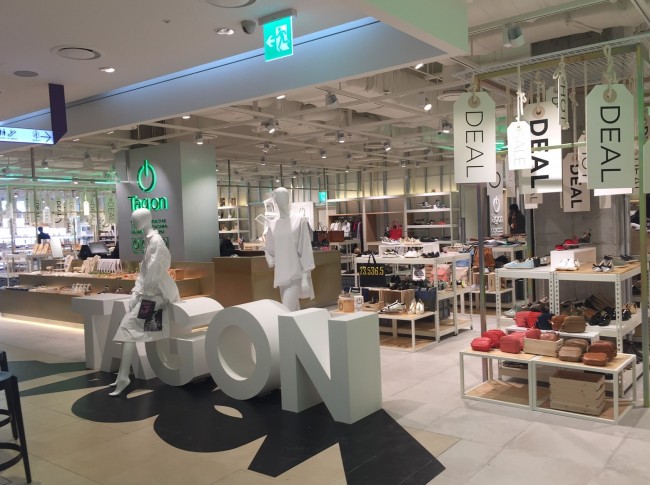Retail & Consumer
Brick-and-mortar fights back
[THE INVESTOR] It‘s a bad time to be in offline retail. Last year, department stores and discount retailers alike saw slow or negative growth as e-commerce operators grew, offering a wider range of products at lower prices with the convenience of online shopping. Consumers no longer saw merit in making their way to a retail outlet to purchase items that they could find online.
Offline retailers, however, are changing their approach to attract customers back to their outlets, either by going big or going small.
 |
View of a Tag On store. AK Plaza |
In 2016 several large new malls opened with the hope of bringing together shopping and a theme park-like experience, providing customers with entertainment in addition to their usual shopping needs.
Shinsegae joined together with Taubman Asia last September to open Starfield Hanam, a gigantic complex that brought the Western-style mall experience to Korea. Shinsegae Department Store stands alongside luxury brands, an indoor water park, a recreational sports park, a movie theater, and a karaoke area. Despite its location outside of Seoul, the mall drew more than 2 million people each month in its first three months.
Shinsegae’s retail rival Lotte also opened up a large mall in the northwestern area of Eunpeyong-gu in Seoul, equipped with a kids‘ park for families looking for a weekend outing destination in the relatively underserved area.
Discount retailer Homeplus joined the fray with an experience-focused branch in Paju, Gyeonggi Province, which combined the retailer’s stores with a culture center and a movie theater.
While these large stores strengthened their food and beverage options and entertainment facilities to take the focus off shopping, smaller, targeted outlets are also emerging which zoom in on specific shopping needs that are not being met in the online space.
Lotte Department Store launched three branches of its mini-department store el CUBE in trendy shopping districts in Seoul last year.
“The proportion of Lotte Department Store‘s customers older than 40 has grown from 54.7 percent to 60.8 percent since 2010, while the proportion of customers in their 20s or below fell from 14.6 percent to 10.4 percent,” Lotte Department Store explained through a statement. “El CUBE seeks out those customers who do not come to department stores.”
Located in the shopping areas of Hongdae, near Ewha Womans University and Garosu-gil, each el CUBE branch features brands that were specifically chosen for the target demographic in each area, remaining small with store space under 900 square meters.
The Hongdae branch targets consumers aged 17-22 with character brands, low-end cosmetics and dessert shops. In front of Ewha Womans University, the target is 20-24-year-olds with trendy design product brands and cosmetics. At the Garosugil branch, which draws 27-33 year olds, the brands include home design brands and fashionable luxury items.
Lotte Department Store says that it plans to add about ten new specialized stores targeting product categories such as cosmetics, home living and men’s products in 2017.
AK Plaza followed suit with its Official Holiday by Koon and Tag On mini-department stores in Garosugil and Hongdae, respectively.
Official Holiday by Koon is a fashion and lifestyle department store that offers exclusive products through partnerships with established and rising designers. AK Plaza works with the designer through the design, production and merchandising process, allowing consumers to find unique products at about 80 percent of the price of other established brands.
Official Holiday by Koon had an average of 8,000 visitors a month in its first six months after opening in April, with about 300 million won in sales each month.
Meanwhile, Tag On in Hongdae focuses on products from Korea and overseas that offer the most value for price, merchandising on the product level than on the brand level. Over 60 percent of Tag On‘s customers are in their early 20s, looking for accessories, jewelry, lifestyle products and unisex clothing.
“Large offline stores that compete on scale have reached their limit,” said Kim Young-bok, who heads up the product unit at AK Plaza. “It has become more important for Korean retailers to customize their offerings with brands that meet customer needs in the right districts.”
By Won Ho-jung/The Korea Herald (hjwon@heraldcorp.com)








